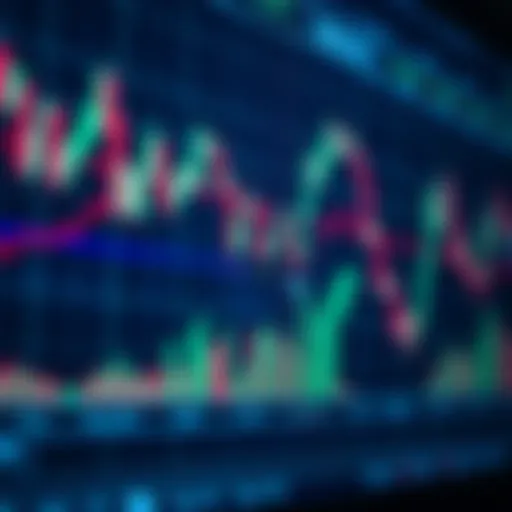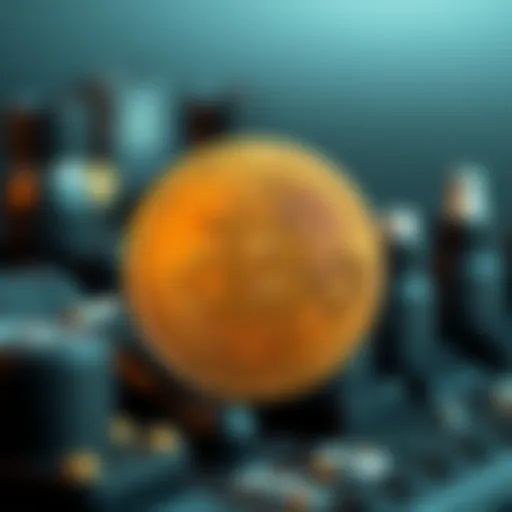The High-End World of NFT Art Sales
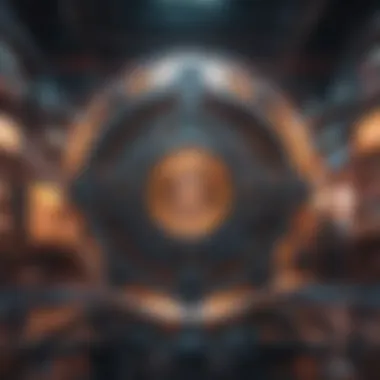

Intro
The digital art world has undergone a metamorphosis in the last few years, igniting debates, raising eyebrows, and averting gazes with astonishing pieces commanding eye-watering prices. With a mixture of excitement and skepticism, individuals are navigating this bold new frontier of creativity combined with technology. What draws an investor toward a digital artwork, and why do some pieces sell for exorbitant amounts? These questions are at the heart of our exploration into the realm of NFT art.
NFTs, or non-fungible tokens, offer an innovative approach to ownership in the digital sphere, transforming the way artists, collectors, and investors interact. As the buzz around these tokens grows, so do the valuations of top-notch pieces, capturing the attention of both the art aficionados and the crypto-savvy. In this article, we aim to traverse the intricate landscape of NFT art sales, uncover the driving factors behind staggering price tags, and highlight the notable artists rewriting the narrative of modern art.
Market Analysis
The NFT art market has blossomed at an extraordinary pace, fueled by a confluence of technological advancements and a wider embrace of digital ownership in the cryptocurrency ecosystem. To understand this shift, we need to probe into two key areas: current trends in cryptocurrency and the methods of price prediction.
Current Trends in Cryptocurrency
As more people get familiar with cryptocurrencies, they become a potent tool for both investment and transaction. This arises from
- Increased Adoption: Major brands are integrating cryptocurrencies, shaping a culture of acceptance.
- Diverse Platforms: Various marketplaces like OpenSea, Rarible, and Foundation are gaining traction, offering easier access for collectors.
- Community Engagement: Online communities on platforms like Reddit and Twitter fuel discussions and interest, spurring trends in NFT creations.
The possibility of digital ownership is leading to questions of legitimacy, scarcity, and ultimately, value. Investors are on the lookout for the next big art piece, asking, "Is it worth it?"
Price Prediction Techniques
Predicting prices in the NFT art market requires a savvy understanding, unique methods, and a dash of intuition. Some effective techniques encompass:
- Historical Data Analysis: By examining past sales and current market trends, one can gauge the potential of a piece.
- Artist Reputation: The influence of an artist's previous work, existing reputation, and social media presence plays a critical role.
- Market Sentiment: Sentiment analysis derived from online discussions, community feedback, or even tweets can hint at the perceived value of specific NFTs.
The price of NFT artwork is not just a reflection of creativity but also holds a mirror to the pulse of cultural phenomena and economic behavior in our technological era.
Investment Strategies
Diving into NFT art sales isn’t just about acquiring beautiful pieces; it also involves navigating complexities of investing. Two prominent strategies emerge in this landscape.
Long-Term vs Short-Term Investing
Artists and collectors often fall into two camps:
- Long-Term Investors: These individuals view NFTs as art collections that appreciate over time, akin to paintings by renowed artists. Their focus typically lies on the piece’s cultural significance.
- Short-Term Traders: These investors thrive on volatility, buying and selling rapidly to take advantage of market trends. They keep an eye on timely events and community shifts to maximize their returns.
Risk Management in Crypto Trading
Just like the stock market, trading in NFTs comes with risks. Strategies for efficient risk management include:
- Diversification: Spread investments across various artists, styles, and marketplaces to mitigate loss.
- Setting Budgets: Establishing a clear budget can prevent overspending, particularly in a heated market.
- Staying Informed: Constantly educate oneself about market trends and new developments in the NFT landscape.
In the vibrant collection of digital art, investors must tread carefully and adapt with the times, lest they find themselves adrift in a tidal wave of price fluctuations and buyer sentiment. As we continue to decode the intricate dynamics of the NFT art market, undeniable insights into valuation, technology, and artistry await.
Prolusion to NFT Art
The emergence of Non-Fungible Tokens (NFTs) has redefined how we perceive art in the digital age. As traditional fluid boundaries between physical and digital mediums blur, understanding what NFT art truly represents becomes essential. NFT art refers to unique digital creations that are verified on a blockchain, turning intangible pixels into collectible assets. This introduction sets the stage for exploring the intricacies and implications of NFT art in the broader market.
Understanding NFT art is crucial for several reasons. First, it provides a fresh lens through which artists can express creativity, extending beyond traditional canvases. Moreover, the digital art landscape is burgeoning, and NFT art has garnered massive interest, alluring investors and creators alike, offering potential financial rewards and collectible value.
Definition of NFT Art
NFT art embodies the fusion of technology and creativity, creating unique digital artworks that are bought and sold on blockchain networks. Each token acts as a digital certificate of ownership, creating a sense of exclusivity, similar to owning a rare piece of physical art. Unlike cryptocurrencies such as Bitcoin, NFTs cannot be exchanged on a one-to-one basis since each one is distinct.
For instance, consider a digital painting by a prominent artist, say, Beeple. Each artwork minted as an NFT is singular in its attributes and ownership, thus holding its value uniquely. Simply put, NFts give permanent digital proof of ownership, bringing scarcity to the digital realm.
Historical Context of NFTs
Tracing back the inception of NFTs paints a fascinating picture. The initial forays into digital ownership began around 2014, with the advent of projects like CryptoPunks. These pixelated characters ushered in an era where digital items could be owned similarly to physical objects. Fast forward to 2021, when Beeple's digitally native artwork "Everydays: The First 5000 Days" sold at Christie’s for a staggering $69 million, igniting mainstream interest.
This pivotal moment catapulted NFT art into the spotlight, illustrating a shift in art consumption and ownership. The rise of platforms like OpenSea and Rarible has only further propelled artists to monetize their work directly, bypassing traditional galleries.
Governments and blockchain enthusiasts have begun to notice as well, creating discussions around digital ownership, copyright, and the environmental impact of blockchain technology. Thus, the historical evolution of NFTs encapsulates not only technological advancements but also a broader cultural shift towards valuing digital art just as profoundly as traditional works.
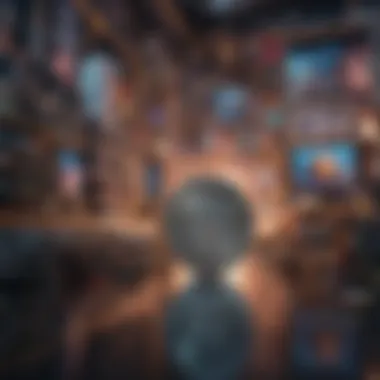

The Emergence of High-Value NFT Art
The rise of high-value NFT art is not just a fleeting trend; it's a profound evolution in the art world that intertwines creativity with technology and investment. For many, NFTs represent more than digital pixels—they're a veritable ticket to the future of ownership and commerce in art. As we dig deeper into this phenomenon, it's crucial to consider the elements that have led to the substantial valuations and the shifting dynamics in art sales.
Factors Driving High Valuations
Several key factors fuel the high valuations of NFT artworks, which insist on our careful attention:
- Scarcity and Exclusivity: Just like traditional art, the limited availability of certain NFTs enhances their desirability. Artists create a finite number of tokens for their pieces, inherently driving up demand. It becomes a classic case of want what you can’t have—a sentiment that resonates deeply in collectors’ minds.
- Provenance and Authenticity: With blockchain technology, the ownership history of an NFT is transparent and immutable. This record appeals strongly to buyers, as they know they are investing in something genuine. The allure of owning a piece that has a verified lineage can dramatically escalate its value.
- Social Status and Community: Owning expensive NFT art can be akin to owning a rare diamond. It quite frequently serves as a status symbol among peers. The art community is increasingly forming around these digital pieces, with social media platforms buzzing about these acquisitions, further inflating their worth.
"In the world of NFTs, your wallet does the talking. The size and prestige of your collection can command respect and admiration in equal measure."
- Cultural Relevance and Timing: The cultural context and timing of the piece's release interplay significantly in its valuation. Artists tapping into current themes, societal issues, or digital shifts often find their work achieving higher sales due to its relevancy and resonance. Such synchronicity captures collectors' imaginations and their investment dollars.
- Celebrity Endorsement: The involvement of high-profile figures can catapult an NFT's value overnight. When celebrities or major influencers promote or create NFTs, the surge in visibility pushes prices upward, regardless of the underlying artistic merit.
Understanding these factors sheds light on the intricate tapestry that constitutes the NFT art market. The interplay of cultural influencers, technology, and the desire for exclusivity creates a landscape ripe for investment and speculation, making buyers keenly aware of the complexities involved in this space.
Market Dynamics of NFT Art Sales
Delving into the dynamics of how NFT art is traded reveals insights that are crucial for any serious investor or enthusiast. The market operates differently compared to traditional art markets, creating both opportunity and risk.
- Online Marketplaces: Platforms like OpenSea, Rarible, and Nifty Gateway, have turned the art buying experience on its head. Artists can reach global audiences without the traditional gallery constraints. Consequently, these marketplaces have become bustling hubs, where prices can swing wildly based on demand and interest.
- Auction Mechanisms: Auctions are a palpable part of the NFT sales scene. Features like bidding wars can inflate values as collectors vie for ownership. It's not uncommon to witness a piece selling for prices that stunned the original artist. These competitive environments can mimic the high-pressure realm of traditional auction houses, albeit with a digital twist.
- Volatility and Speculation: The volatility of the NFT market means prices can fluctuate dramatically within short periods. Investors should prepare for a wild ride, as speculative buying drives up prices before reality brings them back to earth. Awareness of market trends can offer some certainty, but caution remains paramount.
- Community Impact: The engagement of communities in the NFT space is fundamentally transforming how art is perceived and valued. Communities around specific artists or collections can rally behind their favorites, creating a support system that influences market prices significantly.
As NFT art sales evolve, recognizing these dynamics becomes essential for engagement, understanding risks involved, and potentially capitalizing on new opportunities. Investing in this digital art revolution is not merely a financial scenario; It's about grasping the cultural shifts that accompany it.
Notable High-Value NFT Artworks
The world of NFT art has exploded over recent years, shining a spotlight on exceptional pieces that are transforming how we perceive and interact with art in the digital realm. The significance of high-value NFT artworks cannot be overstated, as these pieces often act as barometers for the entire market. Not only do they indicate the financial viability of NFT art as an investment, but they also highlight shifts in artistic expression, cultural trends, and even technological advancements. By probing into these notable works, we can unravel the complexities that underpin their valuation and broader implications within both the art world and the cryptocurrency universe.
Groundbreaking Sales that Reshaped the Market
When we talk about groundbreaking sales in the NFT art space, a few transactions stand out, showcasing not just staggering prices but also redefining the trajectory of digital art ownership.
- Beeple's "Everydays: The First 5000 Days": This piece sold for an eye-popping $69 million at Christie’s auction in March 2021. Beeple, a digital artist whose real name is Mike Winkelmann, had been creating daily artwork for over thirteen years, culminating in this monumental collage. Its sale was not just a tipping point for NFT art but a loud and resounding declaration that digital art can command serious cash.
- CryptoPunk #7804 and #3100: These two CryptoPunks sold for around $7.5 million each. These 24x24 pixelated images are among the first NFTs on the Ethereum blockchain, and their desirability stems from their historical significance and the scarcity of only 10,000 available punks. Their sales marks a notable moment in mainstream recognition of NFTs.
- Pak’s "The Merge": This piece raked in an astonishing $91.8 million through a unique sales model that allowed collectors to essentially buy a share of the artwork. It emphasized the notion of fractional ownership, bringing to light new dimensions in how artwork can be philiosophically perceived and monetarily handled.
These sales didn’t occur in isolation; they generated discussions around the sustainability of the market, environmental concerns about blockchain technology, and the future of digital art as a legitimate medium.
Profiles of Top-Selling NFT Artists
As the realm of NFT art expands, several artists have distinguished themselves with their innovative approaches and striking sales figures. Notable figures in this domain have not only capitalized on the growing wave of interest but have also shaped the ecosystem itself.
- Beeple: As mentioned, Beeple is a titan in the world of NFT art. His distinct style combines elements of collage, futurism, and social commentary. His meteoric rise serves as a case study in how digital work can gain traction in both traditional and contemporary art spaces.
- Pak: An anonymous artist known for their minimalist aesthetic and conceptual depth, Pak has garnered a massive following and several record-breaking sales. Their projects, like "The Merge," challenge conventional notions of art ownership, taking significant strides toward democratizing art by letting community and collaboration dictate value.
- XCOPY: Focused on unique forms of animation and exploring the darker side of fame and tech culture, XCOPY's works resonate with a tech-savvy audience. Their NFTs are not just art pieces but carry a philosophical weight, often provoking thought on the implications of technology in our lives.
These artists exemplify not only the current landscape of NFT art but also its potential trajectory. Their ability to blend creativity with technological innovation situates them at the forefront of the digital art renaissance.
The Role of Platforms in NFT Sales
In the fast-paced world of NFT art, the platforms facilitating these transactions are paramount. They act as digital galleries where artists showcase their work and collectors purchase pieces. Understanding these platforms is not just a bonus; it’s a necessity for anyone looking to navigate the murky waters of NFT investments. With numerous options available, each with distinct features, understanding how these platforms operate can significantly influence buying and selling decisions.
Leading NFT Marketplaces
When it comes to leading NFT marketplaces, there are a few big players that consistently stand out. Each has its own unique flair and community, which can impact an artist’s visibility and a buyer’s experience. Here are some notable ones:
- OpenSea: Often regarded as the largest marketplace for NFTs, OpenSea supports a vast array of digital assets, from art to virtual land. It operates on the Ethereum blockchain, allowing users to mint, buy, and sell NFTs with relative ease.
- Rarible: This platform has managed to carve its niche by promoting user-generated content. It allows artists to create NFTs without any coding knowledge. Rarible also incorporates a governance token, making it a democratic platform for the community.
- Foundation: Focused on digital art, Foundation operates more as a curated space, emphasizing quality over quantity. Artists need to be invited to sell their works, which can create a sense of exclusivity.
- Nifty Gateway: Unlike most NFT marketplaces, Nifty Gateway offers the option to purchase NFTs using traditional payment methods like credit cards. This unique selling point has broadened its audience significantly.
- SuperRare: This platform emphasizes high-quality artwork and is known for its rigorous vetting process. Artists are selected based on their merit, ensuring that buyers invest in quality pieces.
Each of these platforms brings something different to the table, influencing the kind of NFTs available and the experience of both buyers and sellers.
Evaluating Platform Fees and Policies
It’s not all about the art. Before diving headfirst into buying NFTs, one must be acutely aware of the associated fees on these platforms. The cost of doing business can eat into profits or make a seemingly great deal less attractive. Here are some crucial aspects to consider:
- Transaction Fees: Most platforms charge fees per transaction. OpenSea, for instance, takes a 2.5% fee on sales, which can stack up over time. This fee structure varies, and some platforms have set minimums, affecting the overall cost of investment.
- Gas Fees: On platforms that operate on the Ethereum blockchain, gas fees can be a significant concern. These fees fluctuate based on network congestion and can turn a simple transaction into a costly endeavor.
- Listing Fees: Some platforms may charge artists a fee to list their NFTs, which can serve as a barrier to entry for emerging artists. On the other hand, platforms like Rarible allow free listings, promoting a more inclusive environment.
- Withdrawal Fees: If collectors want to sell an NFT and cash out their earnings, certain platforms impose a fee for transferring funds back to their wallets. It's essential to know these charges upfront.
- Royalties: Artists often set royalty percentages for secondary sales. Platforms usually enforce these terms, ensuring that creators can still benefit from future transactions of their art.
Understanding these fees can help buyers and artists make informed decisions. It is always wise to do due diligence on each platform’s policies to avoid any unwelcome surprises that can affect the profitability of an investment.
"The key to mastering the NFT market lies not only in the art itself but also in being fluent in the language of the platforms that sell it."
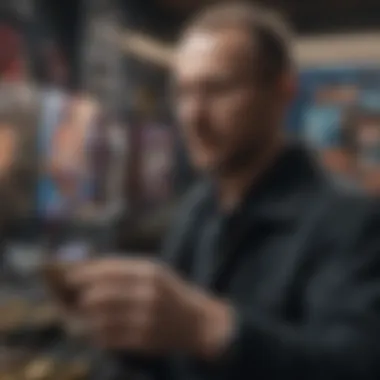

Investment Potential in NFT Art
The world of NFT art has transformed the way people perceive and invest in digital assets. Understanding the investment potential in this realm is crucial for anyone looking to navigate the waters of high-value digital art. As traditional investment avenues become saturated, NFT art presents a new frontier, promising unique opportunities as well as challenges. This section will delve into the nuances of investing in NFT art, including what drives its value and essential considerations for potential investors.
Understanding NFT Investment Strategies
NFTs, or non-fungible tokens, add a novel layer to the concept of ownership in a digital space. For many investors, the allure of NFT art lies in the possibility of substantial financial returns. Here are some prevalent strategies worth considering:
- Diversification of Portfolio: Just like stocks or bonds, including NFTs in your investment portfolio can help reduce risk. Investing in a variety of digital artworks across different platforms and artists might cushion against market volatility.
- Identifying Trending Artists: Keeping an eye on emerging artists who are gaining traction can often lead to lucrative returns. Following social media channels, reading art critiques, and engaging in online communities like Reddit can provide insights into who's hot in the NFT space.
- Long-Term Holding: Some investors choose to buy and hold NFTs, banking on an artist's future success to bolster the value of their earlier works. This Strategy can work well for pieces that are unique or have historical significance, as their value may appreciate over time.
"In the art world, as in life, timing is everything."
- Participation in Auctions: Active engagement in auctions can yield remarkable opportunities for returns. Familiarizing yourself with auction dynamics will enable you to make informed bids without overextending your finances.
Employing these strategies can help demystify the process of investing in NFTs, allowing for more measured and intelligent investment decisions.
Risks Associated with NFT Investments
Like any investment, diving into NFT art comes with its own set of risks. Those considering this digital frontier must be acutely aware of potential pitfalls that could impact their financial outcomes:
- Market Volatility: The NFT market is known for its rapid fluctuations in pricing. One day, a piece may fetch an enormous sum, only to plummet significantly in value the next. Investors must be ready to weather such storms.
- Liquidity Issues: Unlike more traditional assets, finding a buyer for an NFT can be a challenge. The unique nature of these tokens means that not all pieces will have ready buyers, which could lead to longer holding times or forced sales at lower values.
- Fraud and Scams: As the NFT space expands, so do the scams that target unsuspecting investors. It's essential to vet artists and platforms thoroughly to avoid falling prey to counterfeit items or deceptive practices. Always research whether the platforms are reputable to circumvent potential losses.
- Technological Risks: Given that NFTs are fundamentally tied to technology, software malfunctions, or platform failures can indeed impact the ownership and accessibility of your digital assets. Keeping abreast of technological trends and platform stability is prudent.
Potential investors should approach NFT art with a discerning eye, blending optimism about its potential with a pragmatic understanding of the risks involved. Educating oneself and leveraging good strategies while remaining cautious can turn this digital venture into a fruitful investment opportunity.
NFT Art and Digital Ownership
In the ever-evolving landscape of digitally created the art, the melding of technology with ownership concepts stirs up some intriguing discussions. The domain of NFT art is not just about colors and pixels; it shifts the paradigm of what ownership truly means in this digital epoch. With the advent of non-fungible tokens, artists, collectors, and investors reclaim control over their digital assets, yet this brings along a plethora of considerations to navigate.
At its core, NFT art introduces the idea that digital ownership is more than simply possessing a file. When you acquire an NFT, you’re actually buying a unique token on a blockchain that certifies your ownership and authenticity. Therefore, it's not just a pretty piece of digital work; it's akin to holding an original Picasso, albeit in a virtual format. The advantages of this ownership model extend beyond personal collection; for the investor, purchasing high-value NFT art can yield significant financial return potential.
However, diving headfirst into NFT investments without careful thought wouldn't be prudent. The world of crypto is a whirlwind of surprises, with price spikes and crashes that could make anyone squeamish. Thus, understanding digital ownership within the context of NFTs involves recognizing the market dynamics—demand can swing like a pendulum due to social trends, speculative interests, and sudden drops in consumer enthusiasm.
Moreover, as we dig deeper into digital ownership, it’s essential to examine the relevant legalities surrounding NFTs. Questions about copyright, usage rights, and what it means to own a digital piece become paramount. The nuances of such legal aspects often feel like a labyrinth, filled with uncertainties. Notably, collectors should be mindful of what rights they gain when buying an NFT—ownership might not confer authority to reproduce or display the art without restriction.
"NFTs transform digital ownership from an abstract concept into a tangible asset, yet they come wrapped in layers of complexity that demand due diligence."
Ultimately, the intersection of NFT art with digital ownership prompts significant discourse in modern economics and cultural practices, serving as a foundation for the subsequent analysis of ownership in this brave new world.
The Concept of Ownership in the Digital Age
Ownership has morphed significantly in the digital realm. Unlike traditional forms of property, digital assets carry nuances that challenge conventional ideas of ownership. In the art world, the arrival of NFTs introduces a layer of complexity; while one may own a specific NFT, it doesn’t necessarily encapsulate full control over the digital artwork itself.
When an artist creates an NFT and sells it, you're not just purchasing a static image; you're claiming a stake in a blockchain record that proves your acquisition. This is a slippery slope for many collectors to understand, as the rights attached to the ownership of the NFT can vary drastically. As collectors, investors need to peel back the layers of agreements and terms associated with each purchase. For instance, the distinction between owning the NFT versus owning copyright over the art piece is a critical point to grasp.
In essence, the fluid nature of ownership in the digital space necessitates a fresh perspective. Digital ownership isn't about possession alone; it is about engagement, community, and the evolving relationships between creators and their audiences.
Legal Aspects of NFT Ownership
With the thrill of owning an NFT also come the shadows of legal intricacies. Understanding the legal landscape surrounding NFTs is paramount for anyone looking to dip their toes into this market. The central question is—what rights do you actually acquire with your NFT?
Legally, purchasing an NFT typically grants the buyer a license to display or sell the digital artwork, but this doesn’t automatically include copyright ownership. Artists often retain certain rights, meaning they can dictate how their work is used or reproduced. Thus, a clear distinction resides between owning a unique digital token and controlling the underlying artwork itself.
Additionally, regulatory frameworks are still catching up with this new frontier. As jurisdictions worldwide adopt different approaches to blockchain technology and asset ownership, navigating these laws can be somewhat of a minefield. Collectors and investors must stay updated on changes that may impact the functioning of NFT marketplaces and legal recourses available.
The legal aspects, then, call for acute examination and are essential for anyone engaging with NFT art to ensure they make informed choices.
In summary, as we forge deeper into the intricate world of NFT art, it becomes increasingly necessary to comprehensively understand the implications of digital ownership—both in a practical and legal context.
Cultural Impact of NFT Art
The rise of NFT art is reshaping how we perceive creativity, value, and ownership in the digital landscape. No longer confined to traditional galleries and exhibitions, art has transitioned into a global playground where anyone with an internet connection can participate. This revolution has spurred discussions not just about digital assets, but about broader cultural paradigms.
The emergence of NFT art offers fresh lens for analyzing cultural expression in our modern society. It highlights the interplay between technology, creativity, and commerce—presenting both challenges and opportunities for artists and collectors alike. These implications resonate particularly with investors, traders, analysts, and educators who view NFT art not just as frivolous collectibles but as significant cultural artifacts.
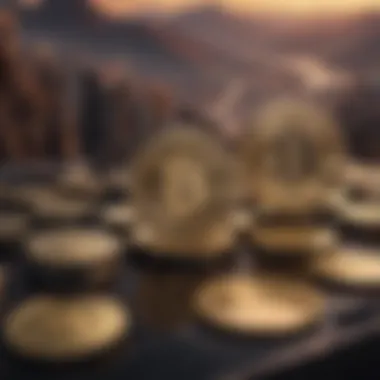

NFTs in Contemporary Art Discourse
NFTs have emerged as a pivotal point in contemporary art conversations. Traditionally, art was viewed as a tangible object, a masterpiece that could be physically owned and exhibited. However, with NFT technology, the value proposition emphasizes digital ownership—an intangible asset that can be bought, sold, and transferred seamlessly across digital platforms. Artists can now engage with their audiences in unprecedented ways, using social media and online marketplaces to reach global audiences directly.
This disruption has also stirred a robust dialogue on what constitutes art in the digital age. The very nature of art is being scrutinized, as creators experiment with new forms of expression. For example, one can point to artists like Beeple, whose work, "Everydays: The First 5000 Days," sold for an eye-popping $69 million. Such transactions signify a cultural shift, making it evident that the definitions of artistic merit and value are evolving.
"NFTs challenge the historical frameworks of art ownership, providing new avenues for artists to monetize their creativity while simultaneously inviting collectors to participate in the digital art economy."
Consumer Trends and Preferences
The increasing interest in NFT art corresponds with changing consumer preferences. As the digital landscape grows, so does the appetite for unique digital experiences. Today's buyers are seeking more than just ownership; they are after a slice of internet history, a mark of cultural significance. This longing plays into the increasing personalization of consumption, where buyers gravitate towards unique items that resonate personally and culturally.
Moreover, recent trends suggest a duality in consumer profiles. On one hand, we have the tech-savvy millennials who see NFTs as both an investment and a new artistic form. On the other, there's an emerging demographic consisting of older, traditional collectors adapting to digital means. This blend of old and new has created a vibrant marketplace where diverse preferences coexist, enriching the cultural tapestry surrounding arts and technology.
Some key consumer insights include:
- Desire for Authenticity: Buyers often seek verified original pieces, emphasizing the importance of provenance.
- Community Engagement: Platforms like Discord and Twitter foster communities around specific NFTs, creating social capital linked to ownership.
- Speculative Investment: Many view NFTs as a hybrid of art and financial investment, further complicating traditional art valuation.
In summary, the cultural impact of NFT art cannot be overstated. It prompts critical reflections on ownership, value, and digital interaction while fueling investor interest and sparking creative collaboration across global boundaries. As technology continues to evolve, so will the discussions around these monumental changes in cultural practices.
Future Trends in NFT Art
The landscape of NFT art is constantly evolving, and keeping an eye on future trends is indispensable for anyone interested in this space. Future developments within NFT art not only influence market dynamics and artist engagements but also shape how consumers and investors interact with digital ownership. Understanding these trends can offer insights into potential investment opportunities, artistic collaborations, and broader cultural shifts.
Technological Advancements to Watch
Technological innovation presents exhilarating possibilities for the NFT art ecosystem. Emerging technologies such as augmented reality (AR) and virtual reality (VR) are starting to reshape how users experience digital art. Imagine walking through a virtual gallery and interacting with digital pieces in a 3D space, rather than just viewing static images on a screen. This immersiveness can attract a wider audience, potentially increasing demand and consequently, value.
In addition, blockchain technology itself continues to evolve. Solutions that improve transaction speeds and reduce energy consumption are likely to become crucial as environmental concerns surround digital asset transactions. Layer-2 solutions that enable faster, cheaper transactions are paving the way for more seamless buying and selling experiences.
"The convergence of art and technology is a powerful force in determining future trends in the NFT space."
With the rise of AI-generated artwork, the combination of algorithms and human creativity is also worth noting. Artists are starting to harness AI not just as a tool, but as a collaborator. This encourages a new form of expression and can result in art that is unexpected and avant-garde, presenting fresh avenues for collectors and investors alike.
Key Technological Trends to Look For:
- Augmented Reality and Virtual Reality Art Experiences.
- Layer-2 Solutions Enhancing Blockchain Efficiency.
- Generative Art Through AI Collaborations.
Evolving Market Patterns
As the NFT art market matures, understanding evolving market patterns is vital for stakeholders. The initial frenzy around NFT art created a speculative bubble, but that appears to be giving way to more sustainable practices. Currently, there’s a noticeable shift toward investors looking for long-term value rather than quick flips.
Moreover, partnerships between traditional artists and NFT enthusiasts foresee a more fluid blending of worlds. This collaboration can reshape buyer preferences and investing strategies. Art institutions are joining the fray, adopting NFTs into their portfolios, which may enhance the credibility of these digital artworks.
Digital scarcity remains pivotal in driving value but new models are emerging. Fractional ownership of NFTs is gaining traction, allowing multiple investors to own a share of high-value pieces. This democratization of ownership could entice more people to participate in the market, influencing overall demand.
Noteworthy Market Trends:
- Sustainable Investing and Long-term Vision.
- Collaborations Between Traditional Artists and NFT Creators.
- Fractional Ownership Models Expanding Participation.
As we forge ahead, recognizing these technological advancements and market patterns provides a roadmap that investors, traders, and tech enthusiasts can navigate. The future holds both excitement and challenges, and staying attuned to these shifts is essential for success in the NFT art realm.
Epilogue
In reflecting on the complex world of NFT art, it becomes evident that understanding its trajectory is crucial for anyone engaged in this space. The conclusion of this exploration aims to crystallize the essence of the key ideas discussed, while also considering what the future holds for both creators and investors in this high-stakes realm.
Summarizing Key Insights
To distill the primary insights gathered throughout this piece:
- Value Dynamics: The valuation of NFT art is not linear; multiple factors affect price points, including market demand, artist reputation, and the association of the artwork within cultural narratives.
- Marketplace Evolution: As technological advancements pave new paths, platforms that facilitate NFT transactions will likely evolve to meet changing consumer behaviors and preferences.
- Legal Considerations: The legal framework surrounding NFT ownership remains murky. As more individuals invest in digital assets, clarifying ownership rights and intellectual property laws will emerge as a top priority.
- Cultural Relevance: NFTs are not merely a financial phenomenon; they also represent a shift in how we perceive art, ownership, and value in a digital context. This ongoing transformation challenges conventional art paradigms and invites new dialogues.
Reflecting these insights reveals that the NFT market is still maturing, and each transaction can tell a story that transcends monetary value alone. The interplay of technology, art, and culture creates a dynamic landscape that ensures sustained interest and evolution.
Final Thoughts on NFT Art's Trajectory
As we gaze into the future of NFT art, it's clear that the journey has only just begun. The convergence of digital technology and artistic expression is not a mere trend; it is indicative of a deeper societal change.
There are a few critical elements to ponder as we move forward:
- Innovation: Artists continue to explore new forms of expression through NFTs, using the medium to challenge expectations and push boundaries. This innovative spirit will likely lead to groundbreaking concepts that redefine the art world.
- Regulatory Landscape: With increased interest from mainstream artists and collectors, regulatory bodies are starting to take note. Understanding how legislation will impact NFT markets is essential.
- Community Engagement: The growing community around NFT art suggests an increasing tendency for collaboration and shared ownership models. This will further enrich the space as fans and creators interact more directly than ever before.
Ultimately, NFT art is a symbol of how technology can redefine our understanding of art and ownership. As both artists and investors alike navigate this brave new world, the lessons learned today will serve as a foundation for tomorrow's endeavors. In essence, as we adapt and innovate, we may find that the most exciting chapters of NFT art are still unwritten.







